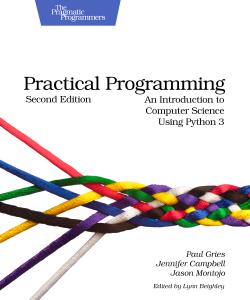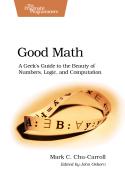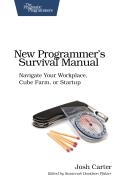About This Title
Pages: 400
Published: September 2013
ISBN: 9781937785451
In Print
Practical Programming (2nd edition)
An Introduction to Computer Science Using Python 3
by Paul Gries, Jennifer Campbell, Jason Montojo
This book is for anyone who wants to understand computer programming. You’ll learn to program in a language that’s used in millions of smartphones, tablets, and PCs. You’ll code along with the book, writing programs to solve real-world problems as you learn the fundamentals of programming using Python 3. You’ll learn about design, algorithms, testing, and debugging, and come away with all the tools you need to produce quality code. In this second edition, we’ve updated almost all the material, incorporating the lessons we’ve learned over the past five years of teaching Python to people new to programming.
Practical Programming, Third Edition, which covers Python 3.6, is now available!
Exercise Solutions:
Chapter
2![]() Chapter
3
Chapter
3![]() Chapter
4
Chapter
4![]() Chapter
5
Chapter
5![]() Chapter
6
Chapter
6![]() Chapter
7
Chapter
7![]() Chapter
8
Chapter
8![]() Chapter
9
Chapter
9![]() Chapter
10
Chapter
10![]() Chapter
11
Chapter
11![]() Chapter
12
Chapter
12![]() Chapter
13
Chapter
13![]() Chapter
14
Chapter
14![]() Chapter
15
Chapter
15![]() Chapter
16
Chapter
16![]() Chapter
17
Chapter
17![]()
eBook Formats:
PDF for desktop/tablets
epub for Apple Books, e-readers
mobi for Kindle readers
Get all eBook formats here for $25.00 (USD)
Paperback Formats:
Order via Bookshop (U.S. Only)
Please support indie bookstores!
Find indie bookstores in the U.S. Find indie bookstores around the world.
You don’t need any programming experience to get started. First, you’ll get a detailed introduction to Python and to programming. You’ll find out exactly what happens when your programs are executed. Through real-world examples, you’ll learn how to work with numbers, text, big data sets, and files. Then you’ll see how to create and use your own data types.
The incremental examples show you the steps and missteps that happen while developing programs, so you know what to expect when you tackle a problem on your own. Inspired by “How to Design Programs” (HtDP), you’ll learn a six-step recipe for designing functions, which helps you as you start to learn the concepts—and becomes an integral part of writing programs by the end.
As you learn to use the fundamental programming tools in the first half of the book, you’ll see how to document and organize your code so that you and other programmers can more easily read and understand it. Beyond the basics, you’ll learn how to ensure that your programs are reliable, and how to work with databases, download data from the web automatically, and build user interfaces. Most importantly, you’ll learn how to think like a professional programmer.
What You Need
You’ll need to download Python 3, available from python.org.With that download comes IDLE, the editor we use for writing and
running Python programs. (If you use Linux, you may need to install
Python 3 and IDLE separately.)
Resources
Releases:
- P3.0 2016/01/07
- P2.0 2014/11/13
- P1.0 2013/09/17
- B8.0 2013/08/04
Contents & Extracts
- What’s Programming?
- Programs and Programming
- What’s a Programming Language?
- What’s a Bug?
- The Difference Between Brackets, Braces, and Parentheses
- Installing Python
- For Instructors: How This Book is Organized
- What You’ll See in This Book
- Hello, Python
excerpt

- How Does a Computer Run a Python Program?
- Expressions and Values: Arithmetic in Python
- What Is a Type?
- Variables and Computer Memory: Remembering Values
- How Python Tells You Something Went Wrong
- A Single Statement That Spans Multiple Lines
- Describing Code
- Making Code Readable
- The Object of This Chapter
- Exercises
- Designing and Using Functions
- Functions that Python Provides
- Memory Addresses: How Python Keeps Track of Values
- Defining our Own Functions
- Using Local Variables for Temporary Storage
- Tracing Function Calls in the Memory Model
- Designing New Functions: A Recipe
- Writing and Running a Program
- Omitting a Return Statement: None
- Dealing with Situations That Your Code Doesn’t Handle
- What Did You Call That?
- Exercises
- Working with Text
excerpt

- Creating Strings of Characters
- Using Special Characters in Strings
- Creating a Multiline String
- Printing Information
- Getting Information from the Keyboard
- Quotes About Strings in This Text
- Exercises
- Making Choices
- A Boolean Type
- Choosing Which Statements to Execute
- Nested If Statements
- Remembering Results of Boolean Expression Evaluation
- You Learned About Booleans: True or False?
- Exercises
- A Modular Approach to Program Organization
- Importing Modules
- Defining Your Own Modules
- Testing Your Code Semiautomatically
- Tips for Grouping Your Functions
- Organizing Our Thoughts
- Exercises
- Using Methods
- Modules, Classes, and Methods
- Calling Methods the Object-Oriented Way
- Exploring String Methods
- What Are Those Underscores?
- A Methodical Review
- Exercises
- Storing Collections of Data Using Lists
- Storing and Accessing Data in Lists
- Modifying Lists
- Operations on Lists
- Slicing Lists
- Aliasing: What’s in a Name?
- List Methods
- Working With a List of Lists
- A Summary List
- Exercises
- Repeating Code Using Loops
- Processing Items in a List
- Processing Characters in Strings
- Looping Over a Range of Numbers
- Nesting Loops in Loops
- Looping Until a Condition Is Reached
- Repetition Based On User Input
- Controlling Loops Using Break and Continue
- Repeating What You’ve Learned
- Exercises
- Reading and Writing Files
- What Kinds of Files Are There?
- Opening a File
- Techniques for Reading Files
- Files over the Internet
- Writing Files
- Writing Algorithms That Use the File-Reading Techniques
- Multiline Records
- Looking Ahead
- Notes to File Away
- Exercises
- Storing Data Using Other Collection Types
- Storing Data Using Sets
- Storing Data Using Tuples
- Storing Data Using Dictionaries
- Inverting a Dictionary
- Using the In Operator on Tuples, Sets, and Dictionaries
- Comparing Collections
- A Collection of New Information
- Exercises
- Designing Algorithms
- Searching for the Smallest Values
- Timing the Functions
- At a Minimum, You Saw This
- Exercises
- Searching and Sorting
excerpt

- Searching a List
- Binary Search
- Sorting
- More Efficient Sorting Algorithms
- Mergesort: An NlogN Algorithm
- Sorting Out What You Learned
- Exercises
- Object-Oriented Programming
- Understanding a Problem Domain
- Function “Isinstance,” Class Object, and Class Book
- Writing a Method in Class Book
- Plugging into Python Syntax: More Special Methods
- A Little Bit of OO Theory
- A Case Study: Molecules, Atoms, and PDB Files
- Classifying What You’ve Learned
- Exercises
- Testing and Debugging
- Why Do You Need to Test?
- Case Study: Testing above_freezing
- Case Study: Testing running_sum
- Choosing Test Cases
- Hunting Bugs
- Bugs We’ve Put in Your Ear
- Exercises
- Creating Graphical User Interfaces
- Using Module Tkinter
- Building a Basic GUI
- Models, Views, and Controllers, Oh My!
- Customizing the Visual Style
- Introducing a Few More Widgets
- Object-Oriented GUIs
- Keeping the Concepts from Being a GUI Mess
- Exercises
- Databases
- Overview
- Creating and Populating
- Retrieving Data
- Updating and Deleting
- Using NULL for Missing Data
- Using Joins to Combine Tables
- Keys and Constraints
- Advanced Features
- Some Data Based On What You Learned
- Exercises
Author
Paul Gries has been teaching in the Department of Computer Science at the University of Toronto for more than 15 years. During his time at UofT, Paul has won numerous teaching awards, including UofT’s most prestigious teaching award and an Ontario-wide teaching award. Paul has also co-authored two textbooks, has been a leader in departmental curriculum design and renewal, and, with Jen, got to teach Python to tens of thousands of students in a MOOC.
Jennifer Campbell is a senior lecturer in the Department of Computer Science at the University of Toronto. Over the past 10 years, Jen’s primary focus has been on teaching and curriculum design of introductory courses. Jen is involved in several projects exploring student experiences in introductory computer science courses and the factors that contribute to success, including the effectiveness of the inverted classroom.
Jason Montojo is a research officer at the Donnelly Centre for Cellular and Biomolecular Research at the University of Toronto, where he develops scientific software for the Cytoscape and GeneMANIA projects. He has a strong interest in teaching computer science and frequently mentors students for Google’s Summer of Code program.
eBook Formats:
PDF for desktop/tablets
epub for Apple Books, e-readers
mobi for Kindle readers
Get all eBook formats here for $25.00 (USD)
Paperback Formats:
Order via Bookshop (U.S. Only)
Please support indie bookstores!
Find indie bookstores in the U.S. Find indie bookstores around the world.
Related Titles:
About This Title
Pages: 400
Published: September 2013
ISBN: 9781937785451
Edition: 2
In Print




